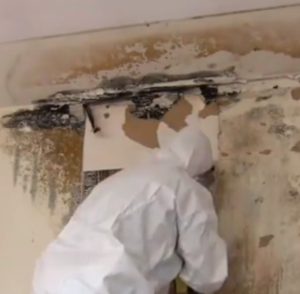One of the worst calls that you can get as an owner is from one of your tenants who tells you that they think there may be mold in your Portland Oregon Rental Property.
If left untreated, mold can be a very expensive problem to deal with because, given the right environment, mold can grow fast.
Sadly, winter is often one of the best times of the year for mold to grow in any home because it’s not uncommon for people to leave their homes, especially in the PDX area.
If it’s snowing, a homeowner or renter will close up their home as tight as possible to keep the cold air out and eliminating airflow is one of the first ways to grow mold because without airflow in a home, and some moisture, mold can literally appear overnight.
How Do You Know If Your PDX Rental Has Mold or Not?
Not sure if your rental has mold? No problem. Sometimes it’s not easy to detect or identify mold but there are several signs that your rental property may have a mold problem including the following:
- Dark-colored spots – They will usually become visible on walls, floors, fabrics, and other surfaces. If you see these spots, clean them up and they return, this is a clear sign that your rental property has mold.
- Musty smell – If your rental property smells musty, this is also another sign that you may have a mold problem because mold often has a strong “pungent” smell that can be difficult to ignore.
- Your tenants are having an allergic reaction – Another sign that you may have a mold problem is if your tenants are possibly having an allergic reaction to the mold. This might include a runny nose, rash, red eyes, sneezing or worse. If they are complaining of reactions like this, mold is the potential culprit and should be eliminated immediately.
Before investing for mold in the rental, it’s best to make sure that your tenants are following good cleaning habits like throwing away trash, food scraps and other garbage instead of leaving it to accumulate in the rental.
They should also be leaving a ceiling or oscillating fan turned on in their rental property during the day, especially when they are away since this will help to keep the air circulated in your rental property.
Where to Check for Mold in Your Rental Property
If you own a single-family rental property in the PDX area, the first obvious place to check for mold in the basement then you should check the attic because these are both places where you can find moisture and mold.
Besides checking the attic and basement, you should also check other damp areas of the rental property that don’t get light or airflow. Some of these places include air ducts, bathroom ceilings, behind toilets, backs of curtains, shelving and closet doors.
Keep in mind that if your rental property has a history of water or flood damage then it’s highly likely that you’re going to find some mold in the home, especially in the areas of the home that may have sustained the flood damage.
How to Take Immediate Action to Stop the Mold
-
Fix the water problem: Whatever is causing the moisture to spread, stop it. Repair the leaky pipe, seal the crack in the foundation, install a vent, run a dehumidifier in the basement—you name it. If you don’t fix the problem at the start, mold will repopulate and waste your remediation efforts.
-
Protect yourself: Wear gloves, a mask, and goggles. We also recommend wearing old clothing you can throw away when done. Use a box fan to circulate fresh air.
-
Seal the affected room off from the rest of the property: Isolate the contaminated area. Close all doors and windows between other rooms on the property. Cover all doorways to the affected room with sheeting, and seal the seams and slip opening entrances of the sheeting with duct tape.
-
Moisten moldy materials to prevent the spread of spores: Stop the spread of dust and airborne spores by misting the contaminated area.
-
Remove affected materials: Open up moldy walls with a screwdriver and remove moldy carpets in sections with a knife. Use a wet-dry vacuum to clean up any debris.
-
Bag what you remove immediately: Discard all wet and moldy materials in plastic trash bags that are 6 mils thick and tie them closed. Note: Mil is the measurement used to classify plastic sheeting—check the package of trash bags to make sure you’re buying the right thickness. Before removing the bags from the contaminated area, wipe them down with a damp cloth and a detergent solution. Then dispose of them as regular trash.
-
Scrub surfaces: Clean moldy non-porous materials and wood surfaces with a wire brush and wipe clean with disposable wipes. Then use a soft brush to scrub all surfaces with a mixture of a quart of water and half a cup of bleach. When you’re done, wipe—but don’t rinse—the surfaces so the bleach can kill the mold.
-
Dry out and clean up: Throw out all supplies when you’re done (including the box fan and your clothes). Remember to bag them in the heavy-duty trash bags as well. Let the cleaned materials dry by using a fan or dehumidifier.
-
Replace all removed materials: If you chucked drywall, insulation, carpeting, curtains, baseboards, window sills, and molding, make sure you replace or repair it. It’s always a good idea to remove a little more than that was affected for good measure.
-
Bring in a professional maintenance crew to clean the entire unit: Have them disinfect every room.
Mold Removal Vs. Remediation – What’s the Difference?
Once you’ve determined that your Portland Oregon Rental Property has mold, the next step is to take steps to remove it professionally.
Since it’s your rental property, we don’t advise attempting to clean it yourself with vinegar or other cleaning supplies since the mold may still come back. For best results, it’s best to call a company that specializes in mold removal or remediation. Here is how their mold remediation process will work:
1. Inspect and Assess Damage
Once a restoration professional has been dispatched to your home, he or she will immediately begin inspecting your property and assessing the extent of water and mold damage. This allows their team to define the project scope, time frame, budget and restoration services needed.
2. Damage Repair
After the damage has been assessed and the root cause is identified, the remediation professional will begin repairing the source of the problem to prevent mold growth from recurring.
3. Mold Removal
During this step, specialized mold remediation equipment, dehumidifiers, and air movers will be used to ensure any remaining water and moisture is removed.
4. Clean and Sanitize
Next, any salvageable areas exposed to the mold damage will be deodorized and cleaned to remove odors and prevent mold growth. Any contaminated materials that cannot be restored will also be safely removed at this time.
5. Reconstruction
The final step to mold remediation is rebuilding and restoring your property back to normal. This step can include repairing structural damage as well as replacing materials such as drywall, carpeting, and flooring.
Get Property Management in Portland Oregon
Are you tired of self-managing your Portland Oregon Investment property or are you interested in changing property management companies? Contact our experienced team of property management professionals at Rent Portland Homes by clicking here to connect with us online.




